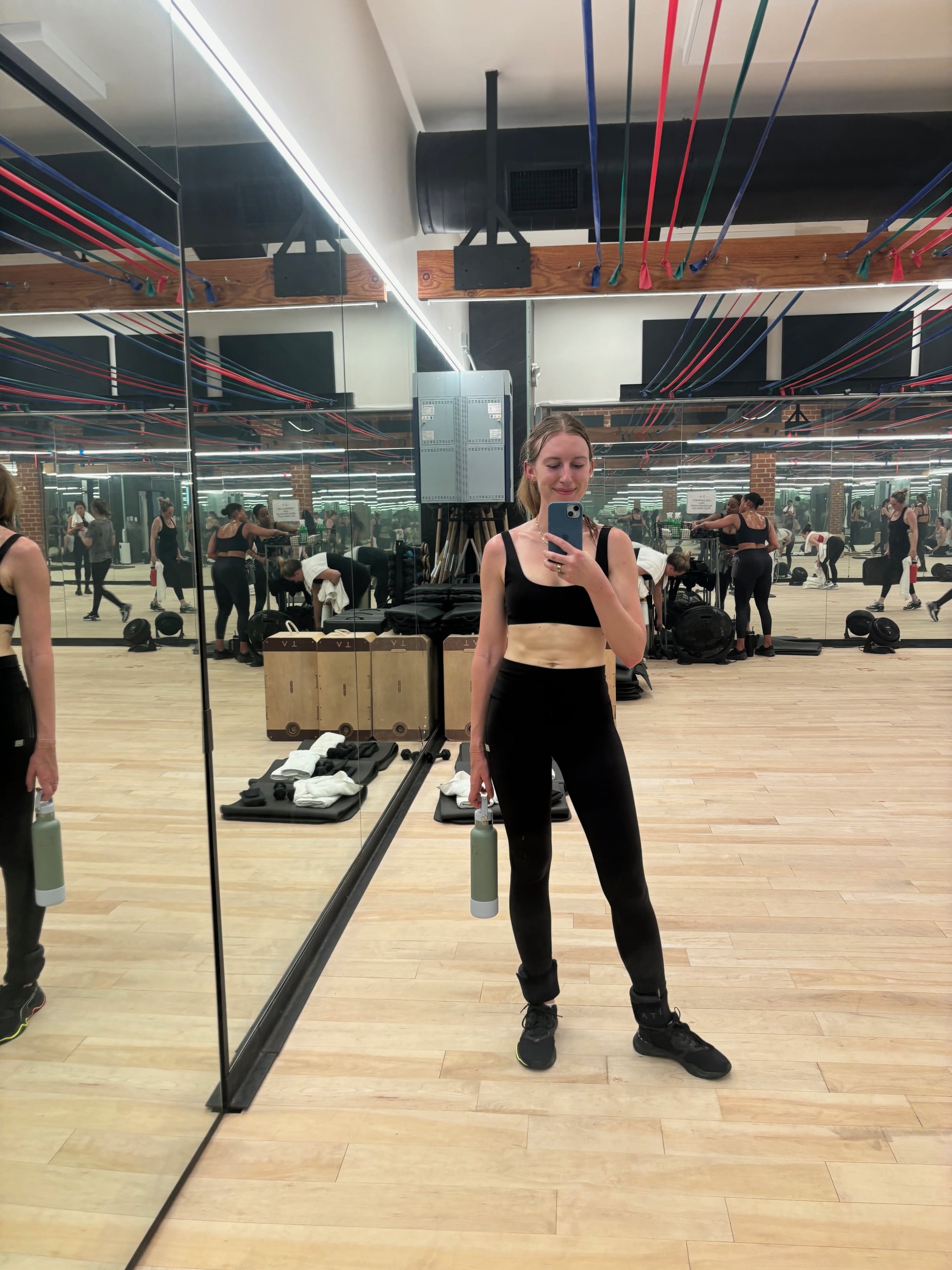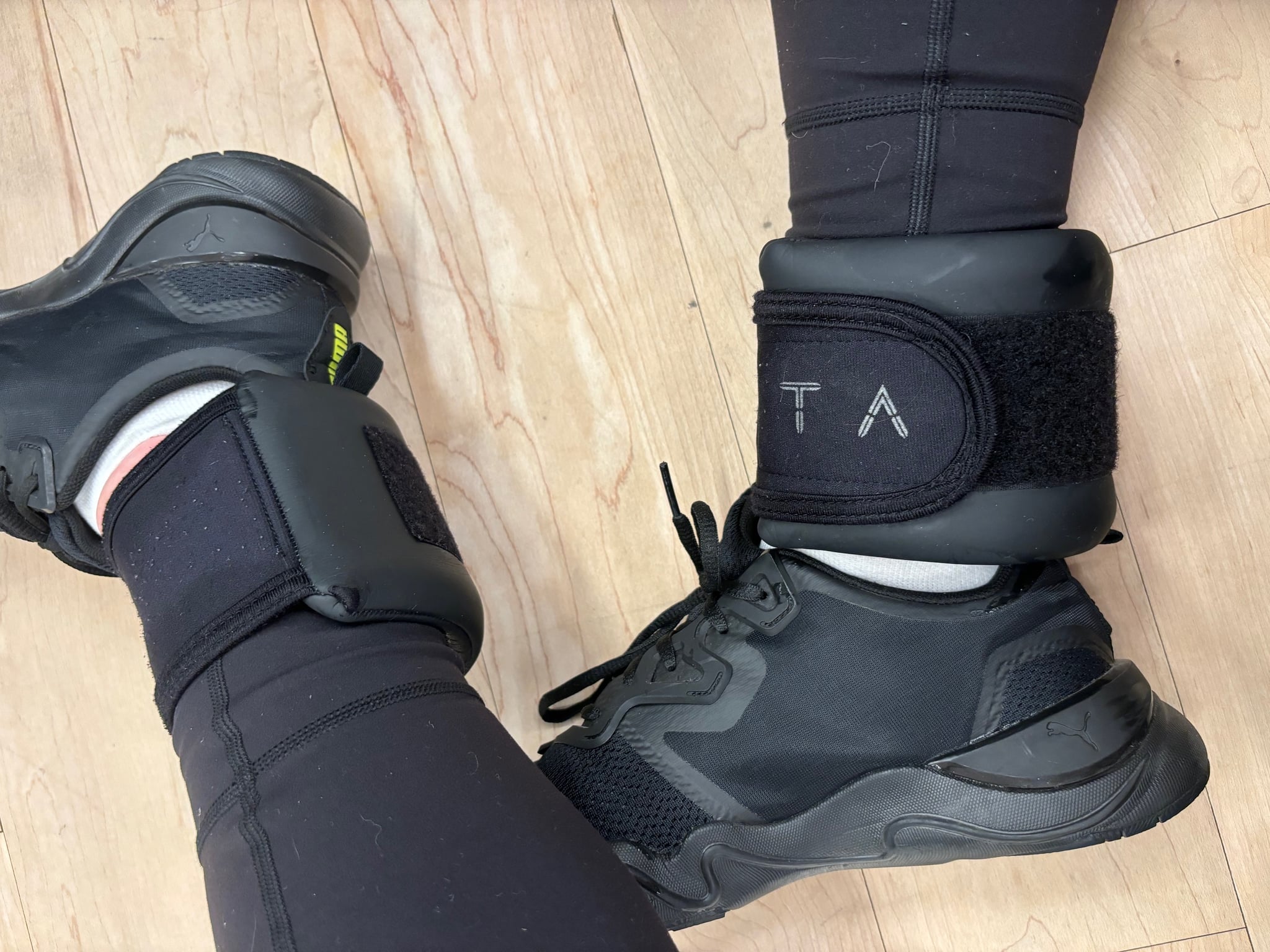“I don’t think I’ve ever sweat this much in my life,” I think as I watch beads of perspiration rain down on the wood floor in front of my mat. I’m in the middle of the second Tracy Anderson Method class I’ve taken in a week, and let me tell you, it is not getting any easier.
If the Tracy Anderson Method (aka TAM) sounds familiar, it’s likely because videos of the studio — with its vibrant, resistance band-lined ceilings and celeb clientele (Jennifer Lopez, Gwyneth Paltrow, and Tracee Ellis Ross are all loyalists) — may have popped up on your social feed.
The fitness method, which now has studios in New York, Los Angeles, Madrid, London, and the Hamptons was created by Anderson over 25 years ago, and quickly became popular in the early 2000s after Anderson teamed up with Gwyneth Paltrow.
At its core, the fitness modality is all about “creating balance in the entire body, which includes your mental, emotional, physical, and spiritual self,” says Olivia Elias, instructor and training manager at Tracy Anderson Method Studio City. It centers around low-weight, high-rep exercises, and each class is designed to strengthen the whole body. The mission, Elias adds, is to help people continue to feel good while moving their bodies, throughout every stage of life.
Although TAM has been around for a while, it’s been getting some extra hype as of late, with a new generation discovering the method (thank you, social media). So, naturally, we had to check it out for ourselves.
What Is the Tracy Anderson Method Like?
When I walk into my first class at TAM Studio City, it feels like I’ve somehow teleported from winter in Los Angeles to mid-August in New York City — that is to say, it’s wildly hot and humid. And no, the AC wasn’t broken. The mugginess is by design. “Our studio environment is a little bit different than other spaces,” Elias says. “We have heat and humidity to make the body feel more flexible, more mobile, and encouraged to move.”
I’m here to take the MultiTAsk Band class, and the studio manager explains to me that all I need to do is follow along with the instructor, ideally using the same color/level of resistance bands as her. As a longtime health and fitness writer, I’ve taken a lot (and I mean a lot) of fitness classes, so I’m feeling pretty confident — however, I quickly realize this is a very unique type of workout.
I find a spot in the middle of the floor, equipped with my mat, a towel, small hand weights, ankle weights, and . . . a large metal rod with a hook at the end. It takes me an embarrassing amount of time to realize that said rod is there to help me pull the resistance bands down from where they’re stretched across the ceiling, in order to use them (please learn from my confusion).

The instructor cranks the music and, without saying a word, begins moving through a series of movements with the resistance bands pulled to her sides. Everyone in the class follows suit, mimicking her every move. “We call it tracking the movement,” Elias says. This taps into our natural instincts, she says, because “as babies we learn by tracking or mimicking.”
At first, I feel clumsy maneuvering the bands — and, admittedly, a bit like I’m a marionette in the NSYNC “Bye Bye Bye” music video (IYKYN). But soon I realize that in order to feel in control, I need to really focus on engaging my core and stabilizing my trunk. And, according to Elias, that’s the whole point.
Once I get the hang of the bands, the class is actually a lot of fun. It reminds me a lot of a dance class (which, admittedly, is not my forte), but it definitely forces me to engage my brain just as much as my body. By the end of this class, I am dripping (truly, dripping) in sweat — so much so that my light-blue activewear set is now an entire shade darker and I realize why most of the women in class are decked out in all-black workout clothes.
So, when I return to the studio to try out their Intermediate Muscular Design class a few days later, I come prepared in an all-black ensemble (seemingly the unofficial uniform of TAM members).
This class skips the bands entirely and instead begins with a dance warmup sequence, which they call the “arm-opening ceremony” at TAM, Elias says, “because it introduces the dialogue with your body, so you can check in with how you’re feeling that day.” This sequence begins with bodyweight only, and then we add small free weights to the mix for a little extra arm challenge.
Next, we put on our ankle weights and move down to the mat. This is where, for me, things feel a bit more tricky. Similar to the band class, there are no verbal cues or instruction, and I find it’s challenging to keep up with the choreography while maintaining proper form. That’s especially true for the moves on all-fours, since I need to crane my neck in order to watch the instructor.
For other TAM beginners like me, Elias recommends first trying the online 30-minute beginner class, which is guided with verbal and visual instructions, similar to a more traditional fitness class. This class serves as an introduction to the types of movements you’ll do in class, which can help build a bit of base knowledge and confidence before jumping into the more challenging routines. “Once that 30-minute zone feels good and manageable for your body, then moving to the intermediate muscular design class online is going to be the best place,” Elias says.
That said, it’s important to note that no matter how long you’ve taken TAM classes, you won’t be able to effortlessly move through the routine. The programming changes on a weekly basis, so the mind and body are both constantly stimulated and challenged, Elias says. “Tracy likes to use as many muscles as possible, at all times, every day — and that goes for our brain as well.”
After a challenging lower-body- and core-focused sequence on the mat, the class wraps the way we started: with a lively dance sesh. At this point, I am (yet again) drenched in sweat and thoroughly exhausted — but I also feel really proud of myself for sticking it out through the tough spots and giving it my best effort.
Does the Tracy Anderson Method Really Work?
I won’t sugarcoat it, this workout class did feel a bit intimidating during my first (and second) try, but I genuinely felt supported and welcomed by the instructors and TAM community.
It’s also important to keep in mind that even if you feel awkward or silly as you acclimate to the movements, no one else in the class is noticing you, because everyone is just as focused on learning the moves.
“Remember it was everyone’s first time once,” Elias says. “So I recommend jumping in with openness, curiosity, and embracing the fact that the content is constantly changing.”
Kristine Thomason is a lifestyle writer and editor based in Southern California. Previously, she was the health and fitness director at Mindbodygreen and the fitness and wellness editor at Women’s Health. Kristine’s work has also appeared in POPSUGAR, Travel + Leisure, Men’s Health, Health, and Refinery29, among others.
Image Source: POPSUGAR Photography / Kristine Thomason
